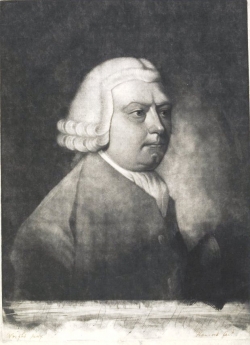
Robert Hancock was born in Badsey, Worcestershire and was baptized there in St James's Church on 7 April 1731was baptised on 7 April 1731. In December of 1745 he was apprenticed to the Birmingham engraver, George Anderton, for a period of 7 years at the costly sum of £30, Anderson being charged a tax on the apprenticeship fee of 15 shillings payable on January 28, 1745/61, Hancock became an accomplished engraver and in 1756-57 he joined the Worcester Porcelain Company, where Josiah Holdship, one of the early partners, had been instrumental in developing printed decoration. It is said that the earliest over glaze prints, known as ‘smoky primitives were produced at Worcester in the early 1750s and by the mid-1750s underglaze blue printing had been perfected. With Hancock’s arrival the factory had access to one of the country’s finest ceramic engravers and their production of printed ware was brought to a high degree of perfection.
When the Worcester company was restructured in 1772, Hancock bought into the partnership for a short time but following disagreements he sold his shares in 1774 and ended his association with Worcester a short time afterwards.
From c.1756 to 1774 he created many designs for use on the porcelain body. Some were adapted from contemporary engravings and paintings, particularly those of the French schools; such romantic scenes as Amusements champêtres and Fêtes vénitiennes were derived from compositions by Antoine Watteau (1684-1721). A series of children's games, including Battledore and Shuttlecock, Blind Man's Buff and Marbles, are based on a series of compositions engraved by Gravelot (1699-1773). Mugs with portraits of Frederick II, King of Prussia, dated 1757, are based on an engraving by Richard Houston (1721/2-75) after a painting by Antoine Pesne (1683-1757) and are among the best-known examples of Hancock's work.
The English schools also provided subjects for Hancock's engravings. A half-length portrait of George III decorates Worcester mugs together with one of Queen Charlotte, both likenesses after engravings by James McArdell. Portraits of Admiral Edward Boscawen, General John Manners, the Marquess of Granby and William Pitt decorate mugs, and these likenesses are considered to be among the best of Hancock's work at Worcester. Hancock had two apprentices, Valentine Green (1739-1813) and James Ross (1745-1821), both of whom later became well-known engravers.
After his departure from Worcester in 1775, Hancock allegedly worked as an agent or partner at Caughley, the pottery works by then part owned by his former apprentice at Worcester, Thomas Turner. From 1780 onwards the artist seems to have worked primarily on mezzotint and stipple portraits and engraved book illustrations. Of his later life little is known, he died on 14 October, 1817 and was buried in Brislington Churchyard two miles from Bristol.
1. Ancestry.com. UK, Register of Duties Paid for Apprentices' Indentures, 1710-1811[database on-line]. © Crown Copyright Images reproduced by courtesy of The National Archives, London, England (accessed online September 14, 2013)References
Cook, Cyril. 1948. The life and work of Robert Hancock; an account of the life of the 18th century engraver and of his designs on Battersea and Staffordshire enamels and Bow and Worcester porcelain. London: Chapman and Hall
Dawson, Aileen. 2009. The art of Worcester porcelain, 1751-1788: masterpieces from the British Museum collection. Hanover, N.H.: University Press of New England.
